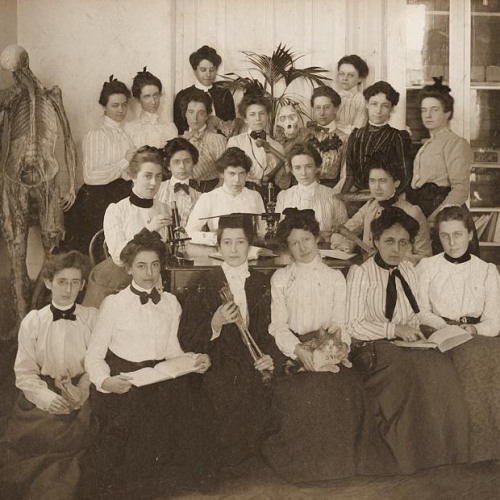This timeline chronicles more than 250 years of Brown University’s history.
These are key milestones from the 1900s.
This timeline chronicles more than 250 years of Brown University’s history.
These are key milestones from the 1900s.
In 1900, the Class of 1899 first organized an association of the women graduates of Brown. The organization was initially named the Andrews Association, in honor of Brown President Elisha Andrews, who worked to help gain women admittance to the college. In 1906, it became the Alumnae Association of Brown University, functioning under that name until the merger of Pembroke College and the men’s college in 1971, when the two alumni clubs merged as well.
1900

David Hall, Class of 1901, was Brown's first Olympian, winning bronze in the 800-meter race in Paris.
1900

Although most of the Women’s College professors at the time were men who received additional payment for teaching the separate women’s classes, an exception was Ada G. Wing (front row, center), who began teaching anatomy to women students in 1897.
1900

Brown’s alumni magazine was launched by a small group of Providence professionals and businessmen with a goal to “bring the University and its graduates into closer touch and sympathy.” Even when, years later, the magazine staff would be housed and paid by the University, the publication would retain its editorial independence.
June 1900
Unique among college companies for its faculty-staff collaboration, Sock and Buskin was formed in 1901 by English Professor Tom Crosby, Class of 1894. The name derived from the Greek dramatic genres: Comedy (represented by the soccus, a slipper-like shoe) and Tragedy (represented by the buskin, a laced half-boot). The all-male Sock and Buskin would combine with the all-female Komians (founded the same year and named for Comus, the god of revelry) in the 1940s.
1901

Built with a bequest from Augustus Stout Van Wickle, Class of 1876, the Van Wickle Gates serve as the ceremonial entry to - and exit from - campus. The center gates remain closed except for two occasions. They are opened inward to admit new students at the Opening Convocation, the ceremonial beginning of the academic year, and outward at Commencement to allow graduates to pass through.
June 18, 1901
Brown’s close neighbor, the co-educational Rhode Island School of Design, opened in 1877. The school entered into cooperative arrangement with Brown in 1902, initially opening three courses to Brown students.
1902

The famed Hutchings-Votey organ in Sayles was donated by Lucian Sharpe, Class of 1893, in honor of his parents in 1903. It is the largest remaining organ of its type.
Transports de joie (L’Ascension) by Olivier Messaien, performed by Mark Steinbach on the organ in Sayles Hall at Brown.
1903
The 95-foot-tall Carrie Tower was erected on the Front Green in 1904. The elegant brick tower with its clock face and intricate stonework, was a gift from Paul Bajnotti in honor of his late wife, Caroline Mathilde Brown, granddaughter of Nicholas Brown, for whom the University is named. Above the entrance door, an inscription reads: “Love is as Strong as Death.” For many years, a set of carillon bells in the tower's dome would chime on the hour.
1904
“Here over the arch at the central point of student life at Brown [Rockefeller Hall Trophy Room, today's Stephen Robert '62 Campus Center], I put the head of a real Brown bear, labeled beyond recognition. The building was formally opened on January 20, 1904, so that is, I suppose, the Brown bear’s birthday.”
— Theodore Francis Green, Class of 1887
January 20, 1904

After amassing a relatively small selection of books from his family and his travels, John Carter Brown, Class of 1816, decided to collect books, printed or made before 1801, on the discovery, exploration and settlement of the Western hemisphere, calling his area of interest, “the Great Subject.” His son, John Nicholas Brown, continued to acquire Americana and add to what by the late 19th century had already become known as the John Carter Brown Library. After the death of John Nicholas in 1900, both the collection and the funds to construct a library building came to Brown. Although located in the center of campus, the John Carter Brown Library is an independently administered and funded library and research center.
May 17, 1904
A graduate of Providence’s Classical High School, Ethel Ester Maria Tremaine Robinson was the first African American female graduate of Brown. She went on to teach English at Howard University and helped in the founding of Alpha Kappa Alpha, the first black sorority n the United States.
1905
In 1907, the new Sayles Gymnasium (now Smith-Buonanno Hall) opened for the use of female students. The building’s facilities included a track, a bowling alley and a “resting room.” Among wider efforts to create a separate women’s culture at the college, the development of physical education was seen as key to attracting a broader range of students.
January 26, 1907

In June 1908, a crowd gathered to watch the unveiling of the equestrian statue of Marcus Aurelius on Lincoln Field behind Sayles Hall. It joined the statue of Caesar Augustus, which had been placed in front of Rhode Island Hall in 1906 (it would be moved to Wriston Quad in 1952). The iconic statues were presented by brothers Moses Brown Ives Goddard and Colonel Robert Hale Ives Goddard.
June 1, 1908